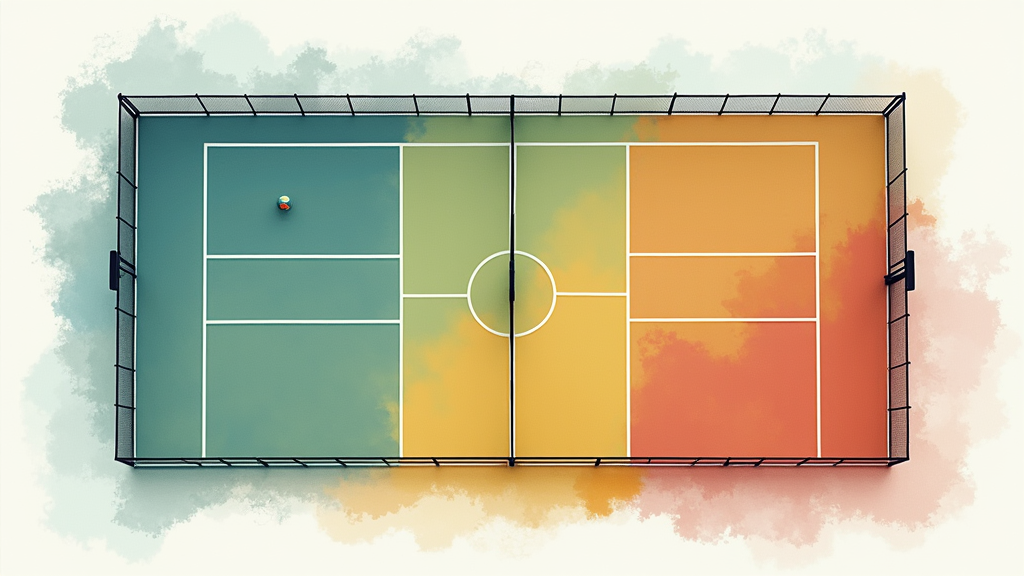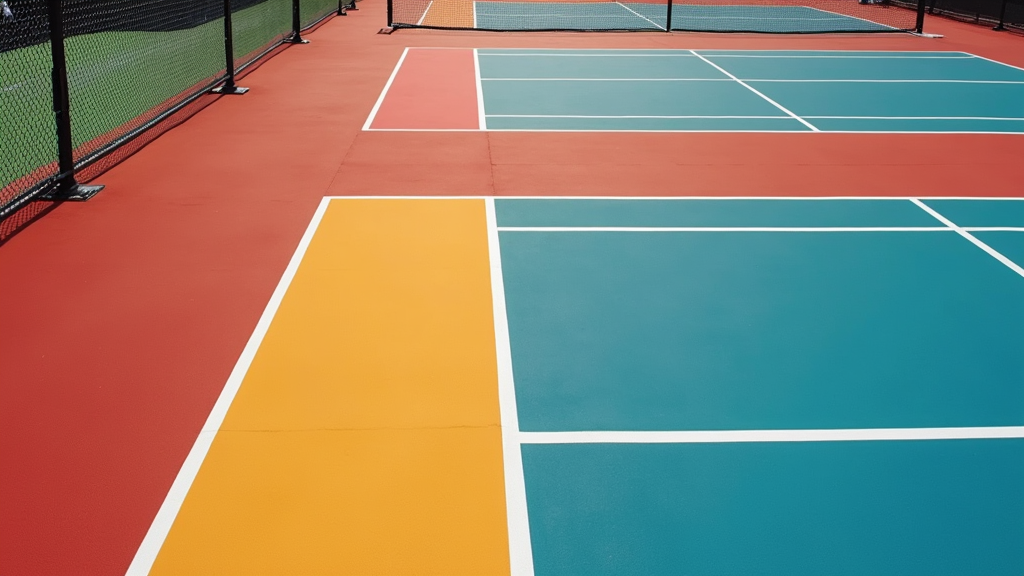Table of Contents
- Understanding Pickleball Court Color Schemes Outline
- Understanding Pickleball Court Color Schemes Outline
- Detailed Guide to Pickleball Court Color Schemes Outline
- Color Selection and Pickleball Court Color Schemes Outline
- Glow Pickleball Court Color Schemes Outline
- Pickleball Court Color Schemes Outline: Final Thoughts
Understanding Pickleball Court Color Schemes Outline

Playability and Aesthetics of Pickleball Court Colors
Pickleball court color schemes play a vital role in both the playability and the overall aesthetics of the court. The right color choices can significantly enhance a player’s ability to track the ball, improve comfort during gameplay, and contribute to the visual appeal of the court. A well-thought-out color scheme is more than just cosmetic; it’s a functional element that directly impacts the quality of the game.
Importance of Contrast in Pickleball Court Design
High contrast between the pickleball and the court surface is absolutely crucial for optimal performance. When players can easily see the ball against the court, their reaction time improves, leading to better shots and a more enjoyable game. Studies have shown that over 70% of pickleball players prefer color combinations that utilize a light-colored court surface with darker lines to minimize glare and maximize visibility.
Evolution of Pickleball Court Color Customization
Historically, pickleball courts were often limited to a few standard color options. However, the trend has shifted dramatically towards greater customization. The introduction of online Court Designer tools has empowered players and facility managers to experiment with personalized color combinations, allowing for unique and visually striking court designs. This evolution reflects a growing understanding of how color can enhance the playing experience.
Impact of Glow Pickleball on Color Trends
The emergence of glow pickleball, a variation played in low-light conditions with illuminated balls and court lines, has further influenced pickleball court color scheme trends. This exciting development has spurred innovation in color choices and paint technologies, leading to brighter, more vibrant courts that are optimized for both daytime and nighttime play. The glow pickleball movement emphasizes the importance of visibility and visual appeal in court design.
Key Takeaways: Choosing Pickleball Court Colors
This guide will provide you with the essential knowledge for selecting the best pickleball court color schemes. You’ll learn how color impacts gameplay, how to choose optimal color combinations for visibility and player comfort, and how to apply paint effectively for durability and long-lasting performance. Whether you are building a new court or resurfacing an existing one, this information will help you make informed decisions that enhance your pickleball experience.
Understanding Pickleball Court Color Schemes Outline
Fundamental Concepts for Pickleball Court Colors
**Expert Insight:** Prioritize high contrast between the ball, court surface, and line markings to optimize visibility and gameplay, as this directly impacts player reaction time and reduces eye strain. Consider lighter-colored court surfaces in warmer climates to enhance player comfort by reflecting sunlight and minimizing heat absorption.
When planning pickleball court color schemes, understanding a few fundamental concepts is crucial for both playability and longevity. These concepts ensure optimal visibility, player comfort, and durability of the court surface.
- Color Contrast:The difference in luminance and/or color is vital for making the pickleball easily distinguishable against the court surface. Higher contrast improves reaction time and reduces eye strain.
- Glare Reduction:Minimizing reflected light, especially on sunny days, enhances player vision. Matte finishes and carefully chosen colors can significantly reduce glare.
- UV Resistance:Protecting the court’s color from fading due to prolonged sunlight exposure is essential. High-quality, UV-resistant paints maintain the court’s appearance and playability over time.
Essential Components of Pickleball Court Color Schemes
A pickleball court color scheme comprises two essential components: the court surface color and the line marking color. Each plays a critical role in the court’s functionality and aesthetics.
The court surface color is the primary color covering the majority of the playing area. Choosing the right color involves several considerations:
- Ball visibility:The primary goal is to select a color that provides excellent contrast with the pickleball, regardless of lighting conditions.
- Impact on player comfort (heat reflection):Lighter colors reflect more sunlight and heat, keeping the court cooler and more comfortable for players, especially in warmer climates.
- Aesthetic appeal:While functionality is paramount, the color should also be visually appealing and complement the surrounding environment.
- Maintenance requirements:Some colors may show dirt and wear more readily than others, impacting maintenance needs.
Important variations include solid colors and blended colors, such as ColorPlus Fusion, which can offer unique visual effects and performance characteristics.
The line marking color is used to define the court boundaries and zones. Key considerations include:
- Contrast with the court surface color:The lines must be highly visible against the court surface to ensure accurate gameplay.
- Compliance with official pickleball regulations:Lines must adhere to official width requirements (2 inches) as specified by pickleball governing bodies.
- Durability of the line paint:The paint used for line markings should be durable and resistant to wear from foot traffic and weather.
- Ease of re-painting:The line marking paint should be easy to apply and maintain, allowing for quick touch-ups as needed.
Common and effective line marking colors include white, yellow, and other highly visible options that provide excellent contrast against various court surface colors.
Detailed Guide to Pickleball Court Color Schemes Outline

Preparation Steps for Pickleball Court Color Schemes
Proper preparation is essential for achieving a professional-looking and long-lasting pickleball court. This involves gathering the necessary materials, setting up the court, and considering important factors that can affect the final outcome.
- Required materials:
- Acrylic paint (specifically designed for sports courts).
- Primer suitable for sports surfaces.
- Professional-grade painter’s tape (minimum width: 2 inches).
- Paint rollers and brushes.
- Cleaning supplies (pressure washer recommended).
- Initial setup:
- Thoroughly clean the court surface using a pressure washer.
- Allow the surface to dry completely (minimum 24 hours).
- Measure and mark the court dimensions according to official pickleball guidelines (court size: 20 feet wide x 44 feet long).
- Important considerations:
- Weather conditions: Avoid painting in direct sunlight or during rain.
- Surface condition: Repair any cracks or imperfections before painting.
- Color selection: Test sample patches of the chosen colors to assess visibility under different lighting conditions.
Step-by-Step Pickleball Court Painting Process
Follow these steps to paint your pickleball court, ensuring a smooth and durable finish. Each step is crucial for achieving optimal results and longevity.
- Step 1: Priming:
- Apply a thin, even coat of primer to the entire court surface using a roller.
- Allow the primer to dry completely (follow manufacturer’s instructions, typically 4-6 hours).
- Step 2: Painting the Base Coat:
- Apply the first coat of the chosen court surface color using a roller.
- Allow the paint to dry completely (follow manufacturer’s instructions, typically 24 hours).
- Apply a second coat for optimal coverage and durability.
- Step 3: Line Marking:
- Apply professional-grade painter’s tape along the marked lines, ensuring straight and precise edges.
- Apply a thin, even coat of line marking paint using a brush or roller.
- Allow the paint to dry slightly (approximately 30 minutes) before applying a second coat.
- Carefully remove the painter’s tape while the paint is still slightly wet to prevent chipping.
Best practices:
- Use high-quality acrylic paint for durability and slip resistance.
- Apply multiple thin coats rather than one thick coat to prevent cracking.
- Allow sufficient drying time between coats.
Common mistakes to avoid:
- Painting on a dirty or damp surface.
- Using low-quality paint.
- Applying paint too thickly.
- Removing painter’s tape when the paint is completely dry.
Advanced Pickleball Court Color Schemes Techniques
Elevate your pickleball court design with these advanced techniques. These tips and methods will help you optimize your court’s appearance and performance.
- Expert tips:
- Consider using a Court Designer tool to visualize different color combinations before painting.
- Consult with professional court painters for expert advice and installation.
- Choose colors that complement the surrounding environment.
- Optimization methods:
- Use lighter colors for outdoor courts to reduce heat absorption.
- Incorporate texture additives to enhance slip resistance.
- Apply a UV-resistant coating to protect the paint from fading.
Troubleshooting:
- Peeling paint:Clean the surface thoroughly and re-apply primer before painting.
- Uneven color:Apply multiple thin coats of paint.
- Fading paint:Use UV-resistant paint and apply a protective coating.
Color Selection and Pickleball Court Color Schemes Outline
Popular Pickleball Court Color Combinations Outline
**Option 1 (Focus on Visibility and Comfort):**
> **Highlight:** Prioritize darker court colors like dark blue or green for enhanced ball visibility, while opting for lighter, cooler colors such as light blue and green to reduce heat absorption and improve player comfort, especially in sunny, outdoor conditions.
**Option 2 (Focus on Cost and Sustainability):**
> **Highlight:** While vibrant colors like bright red or tournament purple can enhance aesthetics, they significantly increase costs; consider using them sparingly. Explore LEED-qualifying colors for a more sustainable and environmentally friendly court, consulting with a professional for specific requirements.
**Option 3 (Focus on Specific Color Combinations):**
> **Highlight:** For competitive play, red and gray offer excellent visibility and high contrast for ball tracking, while yellow and blue are ideal for indoor courts, enhancing visibility under artificial lighting and creating an energetic atmosphere.
Choosing the right color combination is crucial for both aesthetics and playability. Here are some popular choices:
- <strong>Blue and Green:</strong> This combination offers excellent visibility and a calming effect, making it suitable for both indoor and outdoor pickleball courts. The natural and aesthetically pleasing appearance blends well with various environments.
- <strong>Red and Gray:</strong> Providing excellent visibility and a modern look, red and gray offer high contrast, which helps players easily track the ball. This combination is particularly well-suited for competitive play where clear visibility is paramount.
- <strong>Yellow and Blue:</strong> Ideal for indoor pickleball courts, yellow and blue create a bright and energetic playing environment. This vibrant combination enhances visibility under artificial lighting, making it a stimulating choice for players.
<strong>Blue and Green:</strong> This combination offers excellent visibility and a calming effect, making it suitable for both indoor and outdoor pickleball courts. The natural and aesthetically pleasing appearance blends well with various environments.
<strong>Red and Gray:</strong> Providing excellent visibility and a modern look, red and gray offer high contrast, which helps players easily track the ball. This combination is particularly well-suited for competitive play where clear visibility is paramount.
<strong>Yellow and Blue:</strong> Ideal for indoor pickleball courts, yellow and blue create a bright and energetic playing environment. This vibrant combination enhances visibility under artificial lighting, making it a stimulating choice for players.
Factors Influencing Pickleball Court Color Choice
Several factors should influence your color selection to ensure optimal play and comfort:
- <strong>Ball Visibility:</strong> High contrast between the ball (typically yellow or orange) and the court surface is essential. Darker court colors, such as dark blue or dark green, generally provide better contrast and improve ball tracking.
- <strong>Player Comfort:</strong> Lighter colors reflect more sunlight, which reduces heat absorption and enhances player comfort, especially in sunny conditions. Cooler colors like blue and green have a calming effect and can improve player focus during intense matches.
- <strong>Environmental Conditions:</strong> Outdoor pickleball courts require UV-resistant paint to prevent fading and degradation caused by prolonged sun exposure. Indoor courts can benefit from brighter colors to maximize visibility under artificial lighting conditions.
<strong>Ball Visibility:</strong> High contrast between the ball (typically yellow or orange) and the court surface is essential. Darker court colors, such as dark blue or dark green, generally provide better contrast and improve ball tracking.
<strong>Player Comfort:</strong> Lighter colors reflect more sunlight, which reduces heat absorption and enhances player comfort, especially in sunny conditions. Cooler colors like blue and green have a calming effect and can improve player focus during intense matches.
<strong>Environmental Conditions:</strong> Outdoor pickleball courts require UV-resistant paint to prevent fading and degradation caused by prolonged sun exposure. Indoor courts can benefit from brighter colors to maximize visibility under artificial lighting conditions.
Special Color Considerations for Pickleball Courts
Certain color options come with unique considerations regarding aesthetics, cost, and environmental impact:
- <strong>ColorPlus Fusion Blend (Brown):</strong> A 50/50 mix of Maroon & Light Green offers a unique and aesthetically pleasing appearance for your pickleball court. Note that this option may require custom mixing and specialized application techniques.
- <strong>High-Cost Pigments (Brite Red, Tournament Purple, Orange):</strong> Using these vibrant colors may significantly increase the overall cost of your pickleball court project. Consider using them sparingly or as accent colors to manage expenses.
- <strong>LEED Credit Qualifying Colors:</strong> Certain colors may qualify for LEED (Leadership in Energy and Environmental Design) credits, contributing to a more sustainable and environmentally friendly court. Consult with a LEED professional to determine eligible colors and specific requirements for your project.
<strong>ColorPlus Fusion Blend (Brown):</strong> A 50/50 mix of Maroon & Light Green offers a unique and aesthetically pleasing appearance for your pickleball court. Note that this option may require custom mixing and specialized application techniques.
<strong>High-Cost Pigments (Brite Red, Tournament Purple, Orange):</strong> Using these vibrant colors may significantly increase the overall cost of your pickleball court project. Consider using them sparingly or as accent colors to manage expenses.
<strong>LEED Credit Qualifying Colors:</strong> Certain colors may qualify for LEED (Leadership in Energy and Environmental Design) credits, contributing to a more sustainable and environmentally friendly court. Consult with a LEED professional to determine eligible colors and specific requirements for your project.
Glow Pickleball Court Color Schemes Outline

Principles of Glow Pickleball Court Colors
Glow pickleball takes the game to a new dimension with vibrant, UV-reactive colors that transform the court into a luminous arena. The key to successful glow pickleball color schemes lies in understanding how neon and vibrant colors interact with UV or black light to create a visually striking and engaging playing environment.
- Neon and Vibrant Colors:Colors like neon green, vibrant pink, and glowing orange are essential for glow pickleball. These colors are specifically chosen for their ability to stand out dramatically under UV light.
- Contrast with Darkness:Pairing these bright colors with black or dark shades enhances the glow effect, making the luminous colors pop even more. This contrast is crucial for creating a visually stunning and easily navigable court.
- UV-Reactive Paints:Utilizing paints specifically designed to glow under UV light is paramount. These paints must be compatible with the court surface and able to withstand the environmental conditions to ensure longevity and consistent performance.
Popular Glow Pickleball Color Combinations
Selecting the right color combinations can significantly enhance the glow pickleball experience. Here are some popular and effective combinations that maximize visibility and create an exciting atmosphere on the court.
- Neon Green and Black:This high-contrast combination offers excellent visibility under UV light, creating a futuristic and energetic atmosphere. The neon green pops against the dark background, making the lines and playing area distinct.
- Vibrant Pink and Blue:A bold and eye-catching combination that adds a playful and vibrant touch to the court. The contrast between the pink and blue creates a visually stimulating environment that enhances the overall fun of the game.
- Glowing Orange and Yellow:These warm and inviting colors create a cheerful playing environment while enhancing visibility. The glowing orange and yellow combination evokes a sense of excitement and energy, making the game more enjoyable.
Glow Pickleball Court Implementation Techniques
Implementing glow pickleball color schemes effectively requires careful consideration of the materials and techniques used. Proper application and lighting are essential for achieving optimal glow and visibility on the court.
- Glow-in-the-Dark Paints:Applying glow-in-the-dark paint to the court surface, lines, or surrounding areas can significantly enhance the glow effect. Ensure proper charging with UV light for optimal performance and longevity of the glow.
- LED Lighting:Installing LED lighting around the court enhances visibility and creates a dynamic atmosphere. Color-changing LEDs can be used to customize the lighting scheme, adding another layer of visual appeal to the glow pickleball experience.
- UV Black Lights:Strategically positioning UV black lights to illuminate the court enhances the glow effect of the neon colors. Ensure proper coverage and intensity for optimal visibility, creating a truly immersive and exciting playing environment.
Pickleball Court Color Schemes Outline: Final Thoughts
Recap: Key Considerations for Pickleball Court Colors
Color schemes are vital for pickleball court performance and visual appeal. Careful selection impacts ball visibility, player comfort, and overall enjoyment of the game. Don’t underestimate the power of color!
- Consider ball visibility in various lighting conditions.
- Prioritize player comfort by avoiding overly bright or distracting colors.
- Take environmental factors like sunlight and surrounding landscape into account.
- Glow pickleballs introduce exciting color possibilities for nighttime play.
Actionable Advice: Selecting Your Pickleball Court Colors
Before committing to a final color scheme, take these recommendations into consideration. Proper planning ensures optimal court performance and longevity.
- Test sample patches of different color combinations on the court surface.
- Seek guidance from experienced court painters for expert advice and professional installation.
- Choose high-quality acrylic paint designed for sports surfaces.
- Ensure proper application techniques are followed for maximum durability.
Explore Further: Pickleball Court Color Resources
Expand your knowledge and find helpful resources to aid in your pickleball court color selection process.
- Consult the official Pickleball Rules and Regulations for any guidelines on court specifications.
- Utilize online court designer tools to visualize different color combinations and layouts.
- Connect with professional court painting services for expert assistance and high-quality results.

